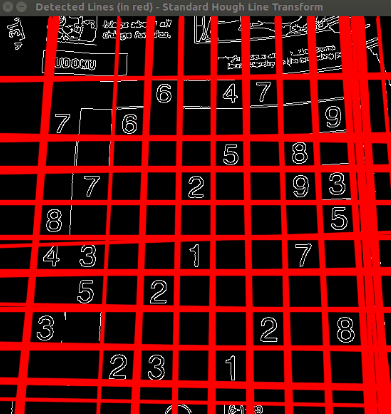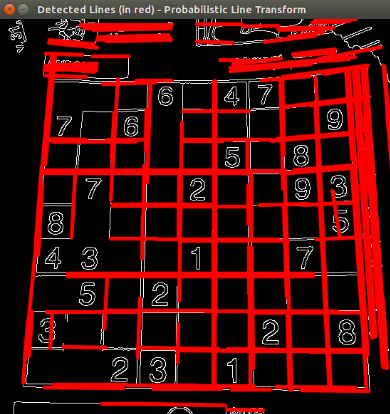hough_lines.markdown 11 KB
Hough Line Transform {#tutorial_hough_lines}
@prev_tutorial{tutorial_canny_detector} @next_tutorial{tutorial_hough_circle}
| | | | -: | :- | | Original author | Ana Huamán | | Compatibility | OpenCV >= 3.0 |
Goal
In this tutorial you will learn how to:
- Use the OpenCV functions HoughLines() and HoughLinesP() to detect lines in an image.
Theory
@note The explanation below belongs to the book Learning OpenCV by Bradski and Kaehler.
Hough Line Transform
-# The Hough Line Transform is a transform used to detect straight lines. -# To apply the Transform, first an edge detection pre-processing is desirable.
How does it work?
-# As you know, a line in the image space can be expressed with two variables. For example:
-# In the **Cartesian coordinate system:** Parameters: \f$(m,b)\f$.
-# In the **Polar coordinate system:** Parameters: \f$(r,\theta)\f$

For Hough Transforms, we will express lines in the *Polar system*. Hence, a line equation can be
written as:
\f[y = \left ( -\dfrac{\cos \theta}{\sin \theta} \right ) x + \left ( \dfrac{r}{\sin \theta} \right )\f]
Arranging the terms: \f$r = x \cos \theta + y \sin \theta\f$
-# In general for each point \f$(x{0}, y{0})\f$, we can define the family of lines that goes through
that point as:
\f[r_{\theta} = x_{0} \cdot \cos \theta + y_{0} \cdot \sin \theta\f]
Meaning that each pair \f$(r_{\theta},\theta)\f$ represents each line that passes by
\f$(x_{0}, y_{0})\f$.
-# If for a given \f$(x{0}, y{0})\f$ we plot the family of lines that goes through it, we get a
sinusoid. For instance, for \f$x_{0} = 8\f$ and \f$y_{0} = 6\f$ we get the following plot (in a plane
\f$\theta\f$ - \f$r\f$):

We consider only points such that \f$r > 0\f$ and \f$0< \theta < 2 \pi\f$.
-# We can do the same operation above for all the points in an image. If the curves of two
different points intersect in the plane \f$\theta\f$ - \f$r\f$, that means that both points belong to a
same line. For instance, following with the example above and drawing the plot for two more
points: \f$x_{1} = 4\f$, \f$y_{1} = 9\f$ and \f$x_{2} = 12\f$, \f$y_{2} = 3\f$, we get:

The three plots intersect in one single point \f$(0.925, 9.6)\f$, these coordinates are the
parameters (\f$\theta, r\f$) or the line in which \f$(x_{0}, y_{0})\f$, \f$(x_{1}, y_{1})\f$ and
\f$(x_{2}, y_{2})\f$ lay.
-# What does all the stuff above mean? It means that in general, a line can be detected by
finding the number of intersections between curves.The more curves intersecting means that the
line represented by that intersection have more points. In general, we can define a *threshold*
of the minimum number of intersections needed to *detect* a line.
-# This is what the Hough Line Transform does. It keeps track of the intersection between curves of
every point in the image. If the number of intersections is above some *threshold*, then it
declares it as a line with the parameters \f$(\theta, r_{\theta})\f$ of the intersection point.
Standard and Probabilistic Hough Line Transform
OpenCV implements two kind of Hough Line Transforms:
a. The Standard Hough Transform
- It consists in pretty much what we just explained in the previous section. It gives you as result a vector of couples \f$(\theta, r_{\theta})\f$
- In OpenCV it is implemented with the function HoughLines()
b. The Probabilistic Hough Line Transform
- A more efficient implementation of the Hough Line Transform. It gives as output the extremes of the detected lines \f$(x{0}, y{0}, x{1}, y{1})\f$
- In OpenCV it is implemented with the function HoughLinesP()
What does this program do?
- Loads an image
- Applies a *Standard Hough Line Transform* and a *Probabilistic Line Transform*.
- Display the original image and the detected line in three windows.
Code
@add_toggle_cpp The sample code that we will explain can be downloaded from here. A slightly fancier version (which shows both Hough standard and probabilistic with trackbars for changing the threshold values) can be found here. @include samples/cpp/tutorial_code/ImgTrans/houghlines.cpp @end_toggle
@add_toggle_java The sample code that we will explain can be downloaded from here. @include samples/java/tutorial_code/ImgTrans/HoughLine/HoughLines.java @end_toggle
@add_toggle_python The sample code that we will explain can be downloaded from here. @include samples/python/tutorial_code/ImgTrans/HoughLine/hough_lines.py @end_toggle
Explanation
Load an image:
@add_toggle_cpp @snippet samples/cpp/tutorial_code/ImgTrans/houghlines.cpp load @end_toggle
@add_toggle_java @snippet samples/java/tutorial_code/ImgTrans/HoughLine/HoughLines.java load @end_toggle
@add_toggle_python @snippet samples/python/tutorial_code/ImgTrans/HoughLine/hough_lines.py load @end_toggle
Detect the edges of the image by using a Canny detector:
@add_toggle_cpp @snippet samples/cpp/tutorial_code/ImgTrans/houghlines.cpp edge_detection @end_toggle
@add_toggle_java @snippet samples/java/tutorial_code/ImgTrans/HoughLine/HoughLines.java edge_detection @end_toggle
@add_toggle_python @snippet samples/python/tutorial_code/ImgTrans/HoughLine/hough_lines.py edge_detection @end_toggle
Now we will apply the Hough Line Transform. We will explain how to use both OpenCV functions available for this purpose.
Standard Hough Line Transform:
First, you apply the Transform:
@add_toggle_cpp @snippet samples/cpp/tutorial_code/ImgTrans/houghlines.cpp hough_lines @end_toggle
@add_toggle_java @snippet samples/java/tutorial_code/ImgTrans/HoughLine/HoughLines.java hough_lines @end_toggle
@add_toggle_python @snippet samples/python/tutorial_code/ImgTrans/HoughLine/hough_lines.py hough_lines @end_toggle
with the following arguments:
- *dst*: Output of the edge detector. It should be a grayscale image (although in fact it is a binary one) - *lines*: A vector that will store the parameters \f$(r,\theta)\f$ of the detected lines - *rho* : The resolution of the parameter \f$r\f$ in pixels. We use **1** pixel. - *theta*: The resolution of the parameter \f$\theta\f$ in radians. We use **1 degree** (CV_PI/180) - *threshold*: The minimum number of intersections to "*detect*" a line - *srn* and *stn*: Default parameters to zero. Check OpenCV reference for more info.
And then you display the result by drawing the lines. @add_toggle_cpp @snippet samples/cpp/tutorial_code/ImgTrans/houghlines.cpp draw_lines @end_toggle
@add_toggle_java @snippet samples/java/tutorial_code/ImgTrans/HoughLine/HoughLines.java draw_lines @end_toggle
@add_toggle_python @snippet samples/python/tutorial_code/ImgTrans/HoughLine/hough_lines.py draw_lines @end_toggle
Probabilistic Hough Line Transform
First you apply the transform:
@add_toggle_cpp @snippet samples/cpp/tutorial_code/ImgTrans/houghlines.cpp hough_lines_p @end_toggle
@add_toggle_java @snippet samples/java/tutorial_code/ImgTrans/HoughLine/HoughLines.java hough_lines_p @end_toggle
@add_toggle_python @snippet samples/python/tutorial_code/ImgTrans/HoughLine/hough_lines.py hough_lines_p @end_toggle
with the arguments:
- *dst*: Output of the edge detector. It should be a grayscale image (although in fact it is a binary one) - *lines*: A vector that will store the parameters \f$(x_{start}, y_{start}, x_{end}, y_{end})\f$ of the detected lines - *rho* : The resolution of the parameter \f$r\f$ in pixels. We use **1** pixel. - *theta*: The resolution of the parameter \f$\theta\f$ in radians. We use **1 degree** (CV_PI/180) - *threshold*: The minimum number of intersections to "*detect*" a line - *minLineLength*: The minimum number of points that can form a line. Lines with less than this number of points are disregarded. - *maxLineGap*: The maximum gap between two points to be considered in the same line.
And then you display the result by drawing the lines.
@add_toggle_cpp @snippet samples/cpp/tutorial_code/ImgTrans/houghlines.cpp draw_lines_p @end_toggle
@add_toggle_java @snippet samples/java/tutorial_code/ImgTrans/HoughLine/HoughLines.java draw_lines_p @end_toggle
@add_toggle_python @snippet samples/python/tutorial_code/ImgTrans/HoughLine/hough_lines.py draw_lines_p @end_toggle
Display the original image and the detected lines:
@add_toggle_cpp @snippet samples/cpp/tutorial_code/ImgTrans/houghlines.cpp imshow @end_toggle
@add_toggle_java @snippet samples/java/tutorial_code/ImgTrans/HoughLine/HoughLines.java imshow @end_toggle
@add_toggle_python @snippet samples/python/tutorial_code/ImgTrans/HoughLine/hough_lines.py imshow @end_toggle
Wait until the user exits the program
@add_toggle_cpp @snippet samples/cpp/tutorial_code/ImgTrans/houghlines.cpp exit @end_toggle
@add_toggle_java @snippet samples/java/tutorial_code/ImgTrans/HoughLine/HoughLines.java exit @end_toggle
@add_toggle_python @snippet samples/python/tutorial_code/ImgTrans/HoughLine/hough_lines.py exit @end_toggle
Result
@note The results below are obtained using the slightly fancier version we mentioned in the Code
section. It still implements the same stuff as above, only adding the Trackbar for the
Threshold.
Using an input image such as a sudoku image.
We get the following result by using the Standard Hough Line Transform:
 And by using the Probabilistic Hough Line Transform:
And by using the Probabilistic Hough Line Transform:

You may observe that the number of lines detected vary while you change the threshold. The explanation is sort of evident: If you establish a higher threshold, fewer lines will be detected (since you will need more points to declare a line detected).